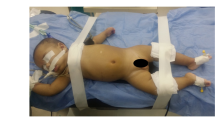Abstract
We have retrospectively evaluated the effectiveness of laparoscopic transperitoneal partial nephrectomy (LTPN) in children in comparison to an age-matched group of children who underwent open partial nephrectomy (OPN) in terms of safety, operative time, narcotic requirements and the length of hospitalization. All patients were divided into two groups. The first group of 10 children with a mean age of 3.6 ± 1.3 years (mean ± SEM) who underwent LTPN compared with an age and gender matched second group of 10 children with a mean age of 3.9 ± 1.4 years who underwent OPN (P = 0.9119). In the first group, 5 upper poles and 5 lower poles partial nephrectomies were performed while in the second group 6 upper moieties and 4 lower moieties partial nephrectomies were performed, respectively. There was a single complication in each group. Intraoperative injury to the unaffected ureter was recognized during LTPN and required conversion to the open surgery in the beginning of learning curve and persistent urinary leakage from collecting system of the remnant pole in the OPN group, which resolved spontaneously. There was no difference in length of surgery and the intraoperative narcotic requirements (P = 0.8182, 0.7638, respectively). However, postoperative narcotic requirements were significantly lower in the first group 0.56 ± 0.29 mg/kg compared to the second group 2.13 ± 0.3 mg/kg, P = 0.0019. LTPN patients had significantly shorter hospitalization 2.7 ± 0.29 days compared with the OPN group 5.1 ± 0.64 days, P = 0.0039. Similar findings were also found in the subgroup of patients younger than 2 years. Median follow up in each group was 28 and 36 months, respectively. Our data show that LTPN is a safe and effective minimally invasive procedure at every age. It has an equivalent operative time, shorter hospitalization and lower postoperative narcotic requirements compared to the open approach.


Similar content being viewed by others
References
Peters CA (2004) Laparoscopic and robotic approach to genitourinary anomalies in children. Urol Clin North Am 31:595–599
Castellan M, Gosalbez R, Carmack AJ et al (2006) Transperitoneal and retroperitoneal laparoscopic heminephrectomy—what approach for which patient? J Urol 176:2636–2639
Lee RS, Retik AB, Borer JG et al (2005) Pediatric retroperitoneal laparoscopic partial nephrectomy: comparison with an age matched cohort of open surgery. J Urol 174:708–712
Piaggio L, Franc-Guimond J, Figueroa TE et al (2006) Comparison of laparoscopic and open partial nephrectomy for duplication anomalies in children. J Urol 175:2269–2273
Hamilton BD, Gatti JM, Cartwright PC et al (2000) Comparison of laparoscopic versus open nephrectomy in pediatric population. J Urol 163:937–941
Ku JH, Yeo WG, Choi H et al (2004) Comparison of retroperitoneal laparoscopic and open nephrectomy for benign renal diseases in children. Urology 63:566–570
Jordan GH, Winslow BH (1993) Laparoendoscopic upper pole partial nephrectomy with ureterectomy. J Urol 150:940–943
Robinson BC, Snow BW, Cartwrigth PC et al (2003) Comparison of laparoscopic versus open partial nephrectomy in a pediatric series. J Urol 169:638–641
El-Ghoneimi A, Farhart W, Bolduc S et al (2003) Retroperitoneal laparoscopic vs open partial nephroureterectomy in children. BJU Int 91(6):532–535
Mor Y, Mouriquand PD, Quimby GF et al (1996) Lower pole heminephrectomy: its role in treating nonfunctioning lower pole segments. J Urol 156:683–685
De Caluwe D, Chertin B, Puri P (2002) Fate of the retained ureteric stump after upper pole hemi-nephrectomy in duplex kidneys. J Urol 168(2):679–680
Mor Y, Goldwasser B, Ben-Chaim J et al (1994) Upper pole heminephrectomy for duplex systems in children: a modified technical approach. BIJ Int 73:584–585
Author information
Authors and Affiliations
Corresponding author
Rights and permissions
About this article
Cite this article
Chertin, B., Ben-Chaim, J., Landau, E.H. et al. Pediatric transperitoneal laparoscopic partial nephrectomy: comparison with an age-matched group undergoing open surgery. Pediatr Surg Int 23, 1233–1236 (2007). https://doi.org/10.1007/s00383-007-2005-8
Accepted:
Published:
Issue Date:
DOI: https://doi.org/10.1007/s00383-007-2005-8




